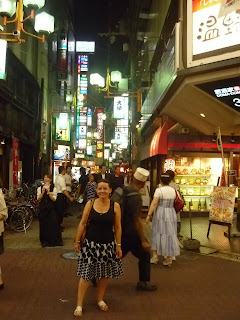
Once again festive season is upon us and this year Jules and I are jetting back home to Australia to celebrate with family and friends. However, before we head off, we have the chance to experience a taste of Japanese Christmas. Like us, you might be surprised that it is even celebrated here at all, considering it’s predominantly Buddhist and Shinto spiritual leanings (less than 1% of the population are actually Christian). However, as is the case with many other western influences, the Japanese have enthusiastically taken Christmas on board. Gone are the biblical references, with the focus of this time of the year on a combination of Santa, family and friends. It is also regarded as somewhat of a time for romance, with Christmas Eve being akin to Valentines Day. Like at home, Christmas decorations are a major part of the celebration and they start to appear in early November. Steadily the build up begins with households and shopping streets throughout Osaka hanging elaborate decorative lights to launch the festive season. This was particularly evident when we recently visited Kobe, where they have one of the most spectacular light shows you could ever hope to see. The illuminations originally began as a commemoration to the victims of the 1995 earthquake and have since grown into a spectacular and quite moving event. For 10 evenings the streets are closed to traffic, while thousands of people slowly parade through a dazzling display of lights, while a stirring choral soundtrack adds to a surprisingly spiritual atmosphere. There is a winter’s chill in the air (not as cold as Paris…more like an Aussie winter), but there is a general feeling of warmth and goodwill in the air. Naturally enough the retail shops use the season as a time to boost trading, with favourite seasonal tunes playing in every store, while decorative trees and displays heavily promote annual Christmas sales. From all accounts Christmas Day itself is a little strange. It is really much like any other; the stores are open, people work and students go to school. We were surprised to read recently that the traditional Christmas dish is Kentucky Fried Chicken!!!.. with the ‘finger lickin’ morsels so popular that you have to pre-book your bucket for the day. Surprisingly, presents are not traditionally given, with much of that saved until the New Year celebrations. Unlike the western world there is also no Christmas hang over and apparently by the day after the decorations have been whisked away for another year. It is certainly very different, but strangely enough you can’t help but sense that the Japanese have managed to get the commercialism of Christmas in perspective. They don’t pretend that it’s anything more than what it is…a feel good time to spend, eat, drink and enjoy in good company!

































